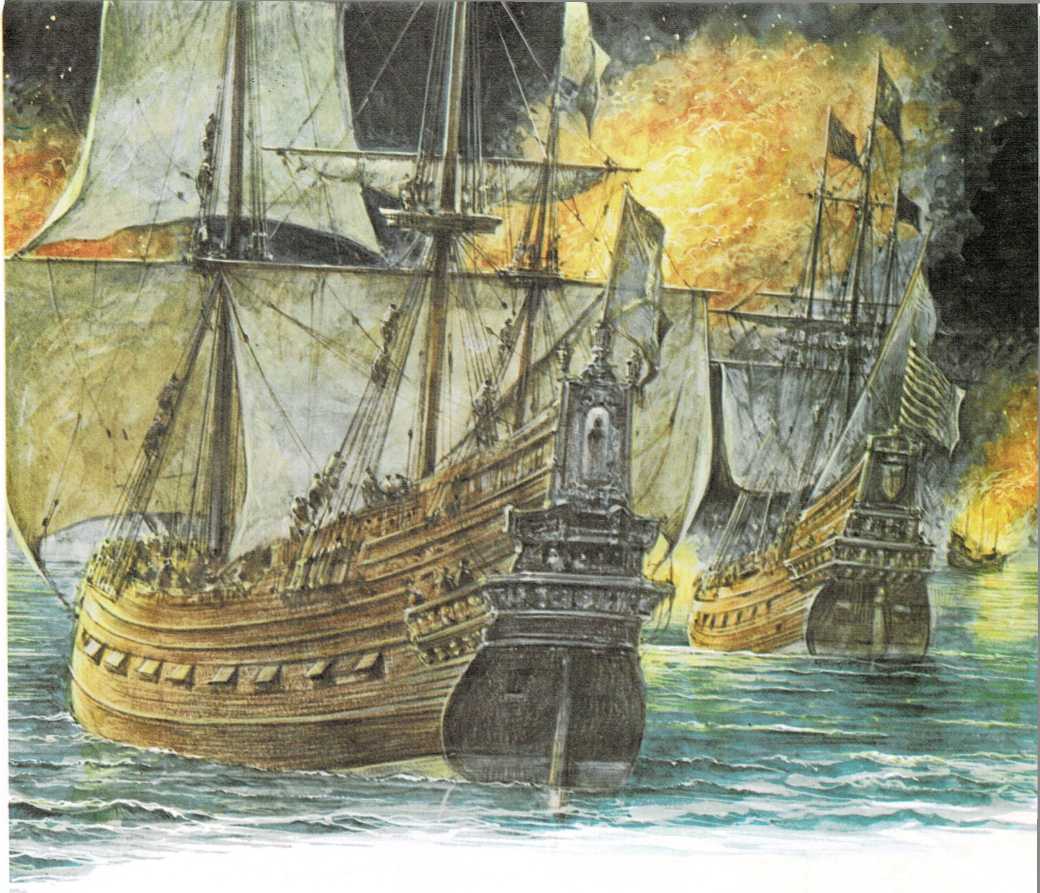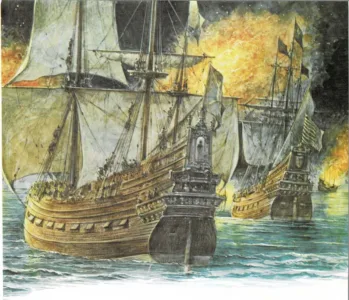The sea battle that saved England
This drawing, made in 1590, pictures the first attack against the
Spanish Armada. Leaving Plymouth (upper right), the English ships sailed
in two groups. One group went south and the other zig-zagged west
(dotted lines), to get behind the huge Armada.
Great, black, iron anchors came sliding up out of the water. Huge sails
began to billow as the wind pushed into them. Yellow and red banners
snapped in the breeze. There were shouted orders, bugle calls, the creak
of wooden boards, and the crackle of canvas sails in the wind. The ships
of the Invincible Armada of Spain moved proudly out to sea.
It was the year 1588. The king of Spain had brought together a great
fleet of 130 ships. This was Spain’s Invincible Armada (which
means \”unbeatable armed force”). The Spanish were about to invade
England!

The main ships of the Armada were twenty big warships called galleons.
These great ships had high sides, a towering stern that rose high above
the water, and rows of cannons on each side. In addition, there were
forty-four large merchant ships that had been turned into warships, and
a number of smaller ships that carried supplies or soldiers.
The English knew the Armada was coming, and they were ready. They, too,
had galleons, but theirs were slimmer, lower, and faster than the
Spanish galleons. They could move and turn more quickly. And, as it
turned out, the English were better seamen.
As the Armada neared England, the English sailed out to attack. The
English knew that the Spanish galleons would try to get as close as
possible, so as to use their heavy, short-range cannon. At the same
time, the Spanish soldiers crowded on the decks would open fire with
their muskets. Then the Spaniards would hurl hooks, attached to ropes,
to catch hold of the enemy ship and pull it close. Hundreds of Spanish
soldiers would leap aboard, cut down the crew, and capture the ship.
Knowing this, the English adopted a simple plan. Their ships had light,
long-range cannon that could fire a cannonball much farther than the
heavier Spanish guns. And, with their faster ships, they knew they could
outsail the Spanish galleons. So, they would sail back and forth out of
range of the Spanish guns as they bombarded the enemy.
Off and on, over the next six days, this is the way the battle went. The
Armada continued to make its way up the English Channel, the strip of
sea that separates England from France. Some Spanish ships were sunk or
captured. No English ships were lost. But neither side could win a
victory. The Spanish, however, were running out of cannonballs. The
English, on the other hand, simply sailed into nearby English ports, got
more cannonballs, and rejoined the fight.
On the evening of the seventh day, the Spanish ships anchored at the
port of Calais, on the coast of France, across from England. The English
could not come into the harbor after them. This would have brought them
too close to the Spanish ships. But the English captains had a plan
ready. They knew how to make the Spaniards come out of the harbor.
Shortly before dawn, Spaniards on watch saw eight ships moving toward
them. Suddenly, the ships burst into flames! The English had steered the
ships into the harbor and then set them afire. If these fire ships got
among the anchored Spanish vessels, dozens would be set ablaze. In
panic, the Spanish captains cut the ropes that held their anchors and
hoisted sail. In the dark, and in their haste to get out of the harbor,
many of the Spanish ships crashed into each other.
This was exactly what the English had hoped for! Now the Armada was
simply a great jumble of ships. As the sun began to rise, the English
attacked!
All day long they dashed in and out among the Spaniards, pounding them
with cannonballs. But as night came on, a sudden


storm broke. The ships on both sides had to stop fighting and look to
their safety in the howling wind and driving rain. The battle came to an
end.
Driven north by the storm, the Armada had to sail all the way around the
British Isles. Most of the ships were badly damaged and leaking. Many
sank. Others, driven helplessly before the wind, were wrecked on the
rocky shore of Ireland. Thousands of men lost their lives. Of the 130
ships that sailed, only 67 got home again.

